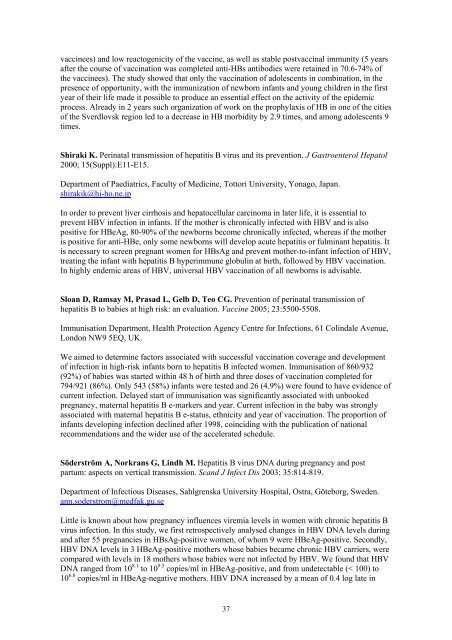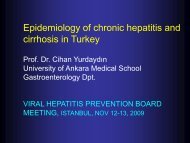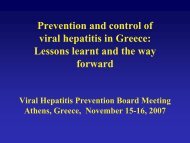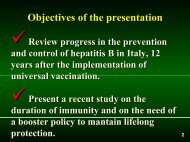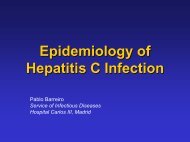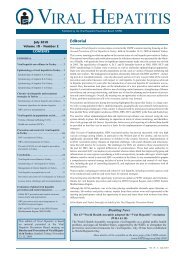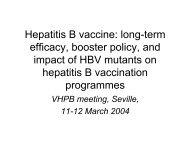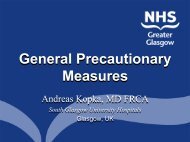Rumi MA, Begum K, Hassan MS, Hasan SM, Azam MG, Hasan KN, Shir<strong>in</strong> M, Khan AK.Detection <strong>of</strong> <strong>hepatitis</strong> B surface antigen <strong>in</strong> pregnant women attend<strong>in</strong>g a public hospital fordelivery: implication for vacc<strong>in</strong>ation strategy <strong>in</strong> Bangladesh. Am J Trop Med Hyg 1998; 59:318-322.Department <strong>of</strong> Immunology, Bangladesh Institute <strong>of</strong> Research <strong>and</strong> Rehabilitation <strong>in</strong> Diabetes,Endocr<strong>in</strong>e <strong>and</strong> Metabolic Disorders, Dhaka.Rout<strong>in</strong>e antenatal <strong>hepatitis</strong> B surface antigen (HBsAg) screen<strong>in</strong>g <strong>and</strong> immunization <strong>of</strong> risk babiesis very effective <strong>in</strong> prevent<strong>in</strong>g <strong>per<strong>in</strong>atal</strong> <strong>transmission</strong> <strong>of</strong> <strong>hepatitis</strong> B <strong>virus</strong> (HBV). We studied 1,800parturients attend<strong>in</strong>g a public hospital to assess the rationale for such vacc<strong>in</strong>ation <strong>in</strong> Bangladesh. Inone <strong>in</strong> every 29 deliveries (63 <strong>of</strong> 1,800 or 3.5%), the mother was found to be HBsAg positive. Allwere asymptomatic <strong>and</strong> many (41 <strong>of</strong> 63 or 65%) without risk factors would rema<strong>in</strong> undetected ifHBsAg screen<strong>in</strong>g were performed on selected groups. Most <strong>of</strong> the HBsAg-positive mothers (54 <strong>of</strong>63 or 85.7%) were found to be chronic carriers <strong>and</strong> 30.2% (19 <strong>of</strong> 63) were also <strong>hepatitis</strong> B eantigen (HBeAg) positive, <strong>in</strong>dicat<strong>in</strong>g high <strong>in</strong>fectivity. Although 23 cord blood were positive forHBsAg or HBeAg, none were positive for IgM antibody to <strong>hepatitis</strong> B core antigen (IgM anti-HBc), suggest<strong>in</strong>g transplacental <strong>transmission</strong> <strong>of</strong> the antigens rather than <strong>in</strong>trauter<strong>in</strong>e <strong>in</strong>fection.These f<strong>in</strong>d<strong>in</strong>gs are discussed <strong>in</strong> relation to the cost-effectiveness <strong>of</strong> rout<strong>in</strong>e prenatal screen<strong>in</strong>g <strong>and</strong>immunization <strong>of</strong> risk babies compared with universal <strong>in</strong>fant immunization.Sanpavat S, Poovorawan Y, Chitt<strong>in</strong><strong>and</strong> S, Bhongsvej S, Thaithumyanon P. Immunogenicity<strong>of</strong> <strong>hepatitis</strong> B vacc<strong>in</strong>e <strong>in</strong> premature <strong>in</strong>fants. Southeast Asian J Trop Med Public Health 1994;25:93-95.Department <strong>of</strong> Pediatrics, Faculty <strong>of</strong> Medic<strong>in</strong>e, Chulalongkorn University, Bangkok, Thail<strong>and</strong>.The immunogenicity <strong>of</strong> plasma-derived <strong>hepatitis</strong> B vacc<strong>in</strong>e was studied <strong>in</strong> 39 premature neonates,whose weights were 1,800-2,400 g <strong>and</strong> gestational ages 32-37 weeks. All maternal anti-HBcantibody were negative. Dosage <strong>of</strong> 5 micrograms <strong>of</strong> <strong>hepatitis</strong> B vacc<strong>in</strong>e (Pasteur vacc<strong>in</strong>e) wasgiven at 0, 1, 2 <strong>and</strong> 12 months after birth. At the ages <strong>of</strong> 1, 2, 4, 9, 12 <strong>and</strong> 13 months, anti-HBsantibody was found <strong>in</strong> 7.7%, 20%, 69.7%, 81.4%, 77.3% <strong>and</strong> 89.5%, respectively, while thegeometric mean titer <strong>in</strong> this seropositive group, start<strong>in</strong>g at age 2 months was 37, 121, 113, 69 <strong>and</strong>1,016 mIU/ml. There was no severe reaction attributed to the vacc<strong>in</strong>ation. The result <strong>in</strong>dicated thatthe vacc<strong>in</strong>e was immunogenic. Although the conversion rate was low after primary <strong>in</strong>jection, asatisfactory response developed at age 4 months after 3 doses <strong>of</strong> vacc<strong>in</strong>e.Shakhgil'dian IV, Mikhailov MI, Khukhlovich PA, Anan'ev VA, Romanenko VV,Kuznetsova IO, Esaulkova AIu, Klimenko SM. The vacc<strong>in</strong>al prophylaxis <strong>of</strong> <strong>hepatitis</strong> B <strong>in</strong>Russia – the achievements, problems <strong>and</strong> outlook. Zh Mikrobiol Epidemiol Immunobiol 2000;2:44-49. [Article <strong>in</strong> Russian]Ivanovsky Research Institute <strong>of</strong> Virology, Gamaleya Research Institute <strong>of</strong> Epidemiology <strong>and</strong>Microbiology, Moscow, Russia.Certa<strong>in</strong> specific features <strong>of</strong> the present epidemic situation with <strong>hepatitis</strong> B (HB) <strong>in</strong> Russia wereestablished: significant growth <strong>of</strong> HB morbidity, start<strong>in</strong>g from 1995; the prevalence <strong>of</strong> personsaged 15-29 years among HB patients, which was l<strong>in</strong>ked with the sharp activation <strong>of</strong> the sexualroute <strong>of</strong> the <strong>transmission</strong> <strong>of</strong> HB <strong>virus</strong> <strong>in</strong> recent years; an essential <strong>in</strong>crease <strong>in</strong> the number <strong>of</strong>patients hav<strong>in</strong>g contacted this <strong>virus</strong> <strong>in</strong> the process <strong>of</strong> the <strong>in</strong>travenous use <strong>of</strong> drugs. The results <strong>of</strong>the use <strong>of</strong> vacc<strong>in</strong>e ‘Engerix B’ among persons belong<strong>in</strong>g to different risk groups were considered(a decrease <strong>in</strong> HB morbidity among them by 8-19 times was noted), the study demonstrated highimmunogenicity anti-HBs antibodies on protective titers were determ<strong>in</strong>ed <strong>in</strong> 92.3-95.7% <strong>of</strong> the36
vacc<strong>in</strong>ees) <strong>and</strong> low reactogenicity <strong>of</strong> the vacc<strong>in</strong>e, as well as stable postvacc<strong>in</strong>al immunity (5 yearsafter the course <strong>of</strong> vacc<strong>in</strong>ation was completed anti-HBs antibodies were reta<strong>in</strong>ed <strong>in</strong> 70.6-74% <strong>of</strong>the vacc<strong>in</strong>ees). The study showed that only the vacc<strong>in</strong>ation <strong>of</strong> adolescents <strong>in</strong> comb<strong>in</strong>ation, <strong>in</strong> thepresence <strong>of</strong> opportunity, with the immunization <strong>of</strong> newborn <strong>in</strong>fants <strong>and</strong> young children <strong>in</strong> the firstyear <strong>of</strong> their life made it possible to produce an essential effect on the activity <strong>of</strong> the epidemicprocess. Already <strong>in</strong> 2 years such organization <strong>of</strong> work on the prophylaxis <strong>of</strong> HB <strong>in</strong> one <strong>of</strong> the cities<strong>of</strong> the Sverdlovsk region led to a decrease <strong>in</strong> HB morbidity by 2.9 times, <strong>and</strong> among adolescents 9times.Shiraki K. Per<strong>in</strong>atal <strong>transmission</strong> <strong>of</strong> <strong>hepatitis</strong> B <strong>virus</strong> <strong>and</strong> its prevention. J Gastroenterol Hepatol2000; 15(Suppl):E11-E15.Department <strong>of</strong> Paediatrics, Faculty <strong>of</strong> Medic<strong>in</strong>e, Tottori University, Yonago, Japan.shirakik@hi-ho.ne.jpIn order to prevent liver cirrhosis <strong>and</strong> hepatocellular carc<strong>in</strong>oma <strong>in</strong> later life, it is essential toprevent HBV <strong>in</strong>fection <strong>in</strong> <strong>in</strong>fants. If the mother is chronically <strong>in</strong>fected with HBV <strong>and</strong> is alsopositive for HBeAg, 80-90% <strong>of</strong> the newborns become chronically <strong>in</strong>fected, whereas if the motheris positive for anti-HBe, only some newborns will develop acute <strong>hepatitis</strong> or fulm<strong>in</strong>ant <strong>hepatitis</strong>. Itis necessary to screen pregnant women for HBsAg <strong>and</strong> prevent mother-to-<strong>in</strong>fant <strong>in</strong>fection <strong>of</strong> HBV,treat<strong>in</strong>g the <strong>in</strong>fant with <strong>hepatitis</strong> B hyperimmune globul<strong>in</strong> at birth, followed by HBV vacc<strong>in</strong>ation.In highly endemic areas <strong>of</strong> HBV, universal HBV vacc<strong>in</strong>ation <strong>of</strong> all newborns is advisable.Sloan D, Ramsay M, Prasad L, Gelb D, Teo CG. <strong>Prevention</strong> <strong>of</strong> <strong>per<strong>in</strong>atal</strong> <strong>transmission</strong> <strong>of</strong><strong>hepatitis</strong> B to babies at high risk: an evaluation. Vacc<strong>in</strong>e 2005; 23:5500-5508.Immunisation Department, Health Protection Agency Centre for Infections, 61 Col<strong>in</strong>dale Avenue,London NW9 5EQ, UK.We aimed to determ<strong>in</strong>e factors associated with successful vacc<strong>in</strong>ation coverage <strong>and</strong> development<strong>of</strong> <strong>in</strong>fection <strong>in</strong> high-risk <strong>in</strong>fants born to <strong>hepatitis</strong> B <strong>in</strong>fected women. Immunisation <strong>of</strong> 860/932(92%) <strong>of</strong> babies was started with<strong>in</strong> 48 h <strong>of</strong> birth <strong>and</strong> three doses <strong>of</strong> vacc<strong>in</strong>ation completed for794/921 (86%). Only 543 (58%) <strong>in</strong>fants were tested <strong>and</strong> 26 (4.9%) were found to have evidence <strong>of</strong>current <strong>in</strong>fection. Delayed start <strong>of</strong> immunisation was significantly associated with unbookedpregnancy, maternal <strong>hepatitis</strong> B e-markers <strong>and</strong> year. Current <strong>in</strong>fection <strong>in</strong> the baby was stronglyassociated with maternal <strong>hepatitis</strong> B e-status, ethnicity <strong>and</strong> year <strong>of</strong> vacc<strong>in</strong>ation. The proportion <strong>of</strong><strong>in</strong>fants develop<strong>in</strong>g <strong>in</strong>fection decl<strong>in</strong>ed after 1998, co<strong>in</strong>cid<strong>in</strong>g with the publication <strong>of</strong> nationalrecommendations <strong>and</strong> the wider use <strong>of</strong> the accelerated schedule.Söderström A, Norkrans G, L<strong>in</strong>dh M. Hepatitis B <strong>virus</strong> DNA dur<strong>in</strong>g pregnancy <strong>and</strong> postpartum: aspects on vertical <strong>transmission</strong>. Sc<strong>and</strong> J Infect Dis 2003; 35:814-819.Department <strong>of</strong> Infectious Diseases, Sahlgrenska University Hospital, Ostra, Göteborg, Sweden.ann.soderstrom@medfak.gu.seLittle is known about how pregnancy <strong>in</strong>fluences viremia levels <strong>in</strong> women with chronic <strong>hepatitis</strong> B<strong>virus</strong> <strong>in</strong>fection. In this study, we first retrospectively analysed changes <strong>in</strong> HBV DNA levels dur<strong>in</strong>g<strong>and</strong> after 55 pregnancies <strong>in</strong> HBsAg-positive women, <strong>of</strong> whom 9 were HBeAg-positive. Secondly,HBV DNA levels <strong>in</strong> 3 HBeAg-positive mothers whose babies became chronic HBV carriers, werecompared with levels <strong>in</strong> 18 mothers whose babies were not <strong>in</strong>fected by HBV. We found that HBVDNA ranged from 10 8.1 to 10 9.5 copies/ml <strong>in</strong> HBeAg-positive, <strong>and</strong> from undetectable (< 100) to10 6.8 copies/ml <strong>in</strong> HBeAg-negative mothers. HBV DNA <strong>in</strong>creased by a mean <strong>of</strong> 0.4 log late <strong>in</strong>37
- Page 1 and 2: Pre-meeting documentPrevention and
- Page 3 and 4: Part I Prevention and control of pe
- Page 5 and 6: prevalence was significantly higher
- Page 7 and 8: clusters (obstetrics wards/hospital
- Page 9 and 10: Boxall E. Screening of pregnant wom
- Page 11 and 12: Chang MH, Hsu HY, Huang LM, Lee PI,
- Page 13 and 14: of infection in infants and childre
- Page 15 and 16: Eriksen EM, Perlman JA, Miller A, M
- Page 17 and 18: liver enzyme abnormalities than wer
- Page 19 and 20: health care, is feasible and achiev
- Page 21 and 22: HBsAg and anti-HBs in 4.5%. In the
- Page 23 and 24: immunoprophylaxis. Reflecting effec
- Page 25 and 26: Levin CE, Nelson CM, Widjaya A, Mon
- Page 27 and 28: Delaying vaccination of premature i
- Page 29 and 30: diagnosis. In the past, the inciden
- Page 31 and 32: shows that the prevalence of HBV in
- Page 33 and 34: Niu MT, Targonski PV, Stoll BJ, Alb
- Page 35: Ranger-Rogez S, Alain S, Denis F. H
- Page 39 and 40: single ELISA test is about Rs40. At
- Page 41 and 42: newborns with surface antigenemia,
- Page 43 and 44: Wang Z, Zhang J, Yang H, Li X, Wen
- Page 45 and 46: of hepatitis B vaccine. This study
- Page 47 and 48: transmission has been estimated at
- Page 49 and 50: at birth and 2 weeks after birth, f
- Page 51 and 52: Chubinishvili OV, Mikhailov MI, Sak
- Page 53 and 54: Jensen L, Heilmann C, Smith E, Want
- Page 55 and 56: Onishchenko GG. Incidence of infect
- Page 57: Zanetti A, Tanzi E, Semprini AE. He


